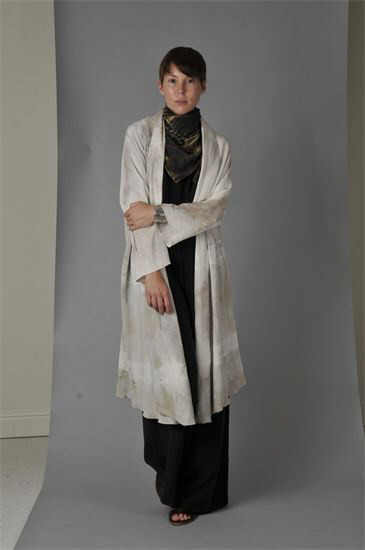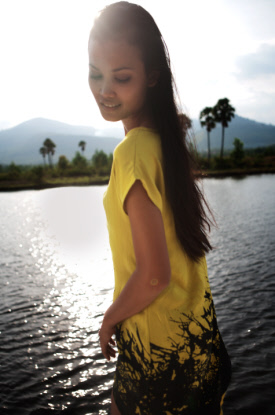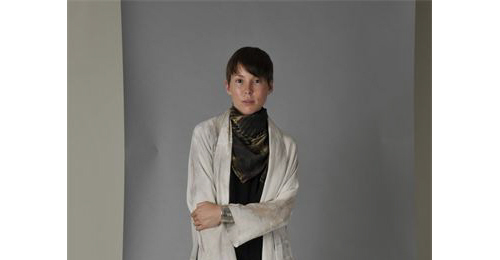
Writer’s Note: Check out my post on how St. Louis is embracing the ‘slow’ fashion and food movements.
I caught up with two of St. Louis’ most talented sustainable designers, Katie Kantley and Genny Cortinovis, on the eve of their Eco-Centric: A Green Fashion Show runway debut to find out what inspired their collections, why ‘slow fashion’ matters to them, and more.
Craft Alliance’s Fashion Lab, a division of the of the non-profit art institution, is hosting the dramatic, outdoor event in Laumeier Sculpture Park, complete with a reception to meet-and-greet the designers and an opportunity to purchase looks from the collection. You can purchase your tickets to here.
Katie of Katie Kantley Boutique is a textile artist well-versed in Japan’s Shibori dying methods, which extracts natural dyes from plants to color fabrics. The designer then repurposes everyday items, like PVC pipe and wine bottles, to create beautiful silk tunics, scarves and jackets, just to name a few of her beautiful creations. Katie shared with me that her Eco-Centric collection is colored using only natural dyes, indigo and madder, a southwest Asian plant.
Dipped and Dyed’s Genevieve (Genny) Cortinovis, is a textile and fashion historian turned designer with a passion for painting, traveling and cultural traditions. She’s learned and worked onside local artisans in France, Ghana and Cambodia and later adopted her own original collections of hand-painted, hand-printed and hand-woven designs.
Continue reading to learn more about these designers and their plans for future collections and how you can own one of their one-of-a-kind, sustainable looks.
Interview with Two of Eco-Centric’s Designers

Katie Kantley: I grew up in the country and still live in rural Missouri. I love to garden and am working to cultivate, harvest, and dye using only the plants in my garden. I have not personally grown the dyes used in this collection, but intend to produce an entirely locally foraged and cultivated collection for the spring.
Genny Cortinovis: The myriad textile traditions across the world are the primary influences on my aesthetic. I have a master’s degree in the history of textiles and fashion so my approach, more often than not, comes from that historic angle. With that being said, my own painting practice and my interest (obsession) with culling patterns from nature has definitely affected my aesthetic.
TP: Which piece(s) in your collection is most reflective of your point-of-view as a designer? Why?
KK: It’s hard to pick just one piece. Every collection that I produce is born from two mandatory design rules. The designs must be machine-washable and comfortable for the wearer. The kimono t-shirt, which I’ve produced for several seasons and once again as part of this collection, meets both of those requirements. It’s so easy to wear and care for. It’s also made of a heavy weight silk crepe that is incredibly strong.
GC: I would say the hand-printed and painted silk sugar palm t-shirt is the most reflective of my point-of-view as a designer today. The print comes from an oil painting that I made in Cambodia’s (nearly Jurassic) Takeo Province and the hand-painting and printing was done in St. Louis. I like that it has an aspect of more “mechanical” reproduction in the silk screening, yet an immediacy and unpredictability in the painting on silk.
TP: What is the message you wish to convey to audiences as they see your collection make its runway debut?
KK: I hope that people recognize the capabilities of natural dyes. Natural dyes, though many require more patience than their synthetic counterparts, can be a beautiful, eco-friendly alternative to the often toxic, synthetic options on the market.
GC: I developed this first collection while living and working with artisans and social enterprises in Cambodia; so, I hope some of the warmth, beauty and tradition of the country and its people rubs off on the audience.
TP: What is your favorite object to repurpose to assist in your dying and/or design processes?
KK: My favorite Shibori method is the Arashi technique, in which I wrap folded silks around PVC odds and ends to create patterns.
GC: Most of the hand-woven silks and some of the cotton jersey is naturally dyed; so, there’s some definite repurposing there. The formula for grey (on cotton) in Cambodia is leaves from a “mouse” tree, palm sugar, limes and rusty nails.
TP: Finish the following sentence: The ‘slow fashion’ movement is important to me because___________.
KK: I believe people rarely think about where their clothing comes from, how it is made, or what impact the production process has on the environment. I hope people will embrace their local fashion designers with the same open arms that they’ve embraced their local farmers and become more knowledgeable of the fashion production process.
GC: Tradition is beautiful (and important).
Eco-chi fashionistas can purchase a look from Katie or Genny’s collections by visiting their websites, www.kantley.com and www.dippedanddyed.com, boutiques, online shops, trunk shows and/or making a special order.

